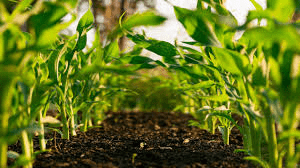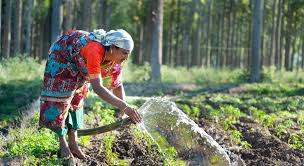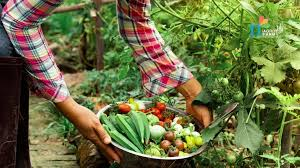Organic farming is a method of agriculture that relies on natural processes and materials to grow crops and raise livestock. This approach avoids the use of synthetic chemicals, such as pesticides and fertilizers, and instead focuses on practices that promote soil health, biodiversity, and ecological balance.
Organic farming aims to produce healthy food while preserving the environment for future generations.
Principles of Organic Farming
Organic farming is guided by several core principles:
1. Health: Organic farming aims to maintain and enhance the health of the soil, plants, animals, and humans. This is achieved by avoiding harmful chemicals and promoting natural processes.
2. Ecology: Organic farming is based on ecological principles, such as recycling nutrients, maintaining soil fertility, and encouraging biodiversity. It seeks to work with nature rather than against it.
3. Fairness: Organic farming promotes fairness by ensuring that farming practices are socially just and economically viable. This includes fair treatment of workers, fair prices for farmers, and fair access to resources.
4. Care: Organic farming emphasizes careful management of natural resources, such as soil, water, and biodiversity, to ensure their long-term sustainability.
Benefits of Organic Farming
Organic farming offers several benefits:
1. Environmental Protection: By avoiding synthetic chemicals, organic farming reduces pollution and protects the environment. It helps preserve soil health, water quality, and biodiversity.
2. Healthier Food: Organic farming produces food that is free from synthetic pesticides and fertilizers. This can lead to healthier, more nutritious food for consumers.
3. Sustainable Agriculture: Organic farming promotes sustainable practices that ensure the long-term health of the soil and the environment. This can help reduce the impact of farming on climate change.
4. Animal Welfare: Organic farming often involves better treatment of animals, with practices that allow them to express natural behaviors and live in healthier environments.
5. Economic Opportunities: Organic farming can provide economic opportunities for small farmers by allowing them to sell their products at premium prices in niche markets.
Read Also: 12 Medicinal Health Benefits Of Renealmia alpinia (Pink cone ginger)
Types of Organic Farming

Organic farming can take many forms, depending on the crops grown, the animals raised, and the specific practices used. Some common types include:
1. Crop Farming: This involves growing a variety of crops, such as vegetables, fruits, grains, and legumes, using organic methods. Crop rotation, composting, and green manures are often used to maintain soil fertility and reduce pests.
2. Livestock Farming: Organic livestock farming focuses on raising animals in natural conditions, with access to outdoor spaces and organic feed. Antibiotics and synthetic hormones are avoided.
3. Mixed Farming: This combines crop farming and livestock farming on the same farm. Animals provide manure for composting, and crops provide feed for the animals, creating a closed-loop system.
4. Permaculture: Permaculture is a holistic approach to farming that integrates plants, animals, people, and the environment into a sustainable system. It emphasizes permanent agriculture and the use of natural patterns.
5. Agroforestry: Agroforestry involves integrating trees and shrubs into crop and livestock systems. This can improve biodiversity, soil health, and farm resilience.
Organic Farming Practices
Organic farming involves a variety of practices designed to work with nature. Some of the most common practices include:
1. Crop Rotation: This practice involves growing different crops in a sequence on the same land to improve soil fertility and reduce pest and disease buildup. For example, a farmer might rotate legumes, which fix nitrogen in the soil, with cereals that use a lot of nitrogen.
2. Composting: Composting involves decomposing organic matter, such as crop residues and animal manure, to create nutrient-rich compost. This is used to enrich the soil and improve its structure.
3. Green Manure: Green manure refers to crops that are grown specifically to be plowed back into the soil. These crops add nutrients, improve soil structure, and suppress weeds.
4. Biological Pest Control: Organic farming relies on natural predators and beneficial insects to control pests. For example, ladybugs can be used to control aphids, and certain fungi can help control plant diseases.
5. Mulching: Mulching involves covering the soil with organic materials, such as straw or leaves, to retain moisture, suppress weeds, and improve soil fertility.
Soil Management in Organic Farming
Soil health is at the heart of organic farming. Here’s how organic farmers manage their soil:
1. Building Soil Fertility: Organic farmers use compost, green manure, and crop rotation to build and maintain soil fertility. These practices add organic matter to the soil, improve its structure, and increase its nutrient content.
2. Preventing Erosion: Organic farmers use techniques like contour plowing, terracing, and cover cropping to prevent soil erosion. These methods help keep the soil in place and reduce the loss of valuable topsoil.
3. Enhancing Soil Biodiversity: Organic farming practices, such as reduced tillage and the use of organic fertilizers, help promote soil biodiversity. A healthy soil ecosystem supports plant growth and helps control pests and diseases.
4. Maintaining Soil pH: Organic farmers monitor and adjust soil pH using natural amendments like lime or sulfur. Maintaining the right pH is essential for nutrient availability and plant health.
Pest and Disease Control in Organic Farming
Controlling pests and diseases without synthetic chemicals is a key challenge in organic farming. Here’s how organic farmers manage it:
1. Cultural Practices: These include crop rotation, intercropping, and planting pest-resistant varieties. These practices help prevent the buildup of pests and diseases by disrupting their life cycles.
2. Physical Barriers: Organic farmers may use nets, row covers, or fences to physically keep pests away from crops. These barriers are effective for protecting crops from insects, birds, and other animals.
3. Biological Control: This involves introducing or encouraging natural predators and beneficial insects that help control pests. For example, releasing ladybugs to eat aphids or using parasitic wasps to control caterpillars.
4. Organic Pesticides: When necessary, organic farmers use pesticides derived from natural sources, such as neem oil or pyrethrum. These products are less harmful to the environment and non-target species.
5. Healthy Soil: Maintaining healthy soil is crucial for preventing plant diseases. Practices like composting and crop rotation help create a soil environment that supports strong, disease-resistant plants.
Organic Fertilizers and Composting
Organic fertilizers and composting are key practices in organic farming that help build healthy soil and support plant growth. Here’s a detailed guide to understanding and using these methods effectively.
Organic Fertilizers
Organic fertilizers are derived from natural sources and are used to improve soil fertility. They provide essential nutrients to plants and help enhance soil health.
1. Types of Organic Fertilizers:
a. Manure: Animal manure, such as from cows, chickens, or horses, is a rich source of nutrients. It improves soil structure and adds organic matter. Ensure it’s well-aged or composted to avoid burning plants and spreading pathogens.
b. Bone Meal: Made from crushed animal bones, bone meal is high in phosphorus, which supports root development and flowering.
c. Blood Meal: This is a byproduct of slaughterhouses and is high in nitrogen, which promotes leaf growth.
d. Fish Emulsion: A liquid fertilizer made from fish byproducts. It’s a good source of nitrogen and other nutrients, and it quickly feeds plants.
2. Applying Organic Fertilizers:
a. Timing: Apply fertilizers based on the needs of your crops and soil. Generally, apply before planting and during the growing season if necessary.
b. Method: For solid fertilizers, spread them evenly on the soil and incorporate them into the top few inches. For liquid fertilizers, apply them to the soil or foliage as directed.
c. Quantity: Follow recommended application rates to avoid over-fertilizing, which can harm plants and the environment.
Composting
Composting is the process of breaking down organic materials into nutrient-rich compost that improves soil health.
1. Starting a Compost Pile:
a. Materials: Collect organic waste such as fruit and vegetable scraps, coffee grounds, eggshells, and yard waste like leaves and grass clippings. Avoid adding meat, dairy, and oily foods.
b. Layering: Create layers in your compost pile: start with coarse materials like branches or straw at the bottom for good aeration, followed by layers of green materials (nitrogen-rich) and brown materials (carbon-rich).
c. Turning the Pile: Aerate the compost by turning it regularly with a pitchfork or shovel. This helps speed up decomposition and prevents odors.
2. Maintaining the Compost:
a. Moisture: Keep the compost moist, but not soggy. It should feel like a wrung-out sponge.
b. Temperature: Composting generates heat. A well-managed pile should reach temperatures between 130-160°F (54-71°C) to kill weed seeds and pathogens.
c. Time: Compost can take a few months to a year to fully decompose. It’s ready when it turns dark and crumbly with an earthy smell.
3. Using Compost:
a. Soil Amendment: Mix compost into garden soil to improve its structure, drainage, and nutrient content.
b. Mulch: Use compost as mulch to retain soil moisture and suppress weeds.
Read Also: 16 Medicinal Health Benefits Of Scleromitrion diffusum (Spreading Diamond Flower)
Crop Rotation and Polyculture in Organic Farming

Crop rotation and polyculture are techniques used to enhance soil health and reduce pest and disease problems.
Crop Rotation
Crop rotation involves growing different types of crops in the same area over successive seasons.
1. Benefits of Crop Rotation:
a. Soil Health: Rotating crops helps balance nutrient levels in the soil and prevents depletion of specific nutrients.
b. Pest and Disease Management: Different crops can interrupt the lifecycle of pests and diseases, reducing their impact.
c. Weed Control: Rotation can help manage weed populations by disrupting their growth cycles.
2. Planning Crop Rotation:
a. Rotation Plan: Create a rotation plan that includes legumes (which fix nitrogen), leafy greens, root crops, and fruiting crops. A typical rotation might be a 3- or 4-year cycle.
b. Record Keeping: Keep detailed records of what crops were planted where and when. This helps in planning future rotations and managing soil health.
Polyculture
Polyculture is the practice of growing multiple types of crops together in the same space.
1. Benefits of Polyculture:
a. Biodiversity: Growing a variety of crops increases biodiversity, which can enhance resilience to pests and diseases.
b. Resource Utilization: Different crops can use resources such as light and nutrients more efficiently when grown together.
c. Reduced Risk: Mixing crops reduces the risk of total crop failure due to pests or diseases affecting a single crop.
2. Implementing Polyculture:
a. Companion Planting: Choose plants that benefit each other. For example, planting marigolds with vegetables can help deter certain pests.
b. Spacing: Plan plant spacing to ensure that crops do not compete too much for light, nutrients, or space.
Livestock Management in Organic Farming
Livestock management in organic farming focuses on ensuring animal welfare and environmental sustainability.
1. Organic Standards for Livestock:
a. Feeding: Organic livestock must be fed organic feed, free from synthetic pesticides and GMOs. They should also have access to pasture.
b. Housing: Animals should have access to clean, comfortable housing that allows them to express natural behaviors.
c. Healthcare: Use natural remedies and preventive measures for health care. Antibiotics and synthetic hormones are generally prohibited.
2. Animal Welfare:
a. Enrichment: Provide enrichment to stimulate natural behaviors. For example, chickens can benefit from pecking and scratching areas.
b. Space Requirements: Ensure animals have adequate space to move around freely. Overcrowding can lead to stress and health issues.
3. Sustainable Practices:
a. Manure Management: Use manure as a valuable resource for composting and fertilizing crops. Proper management prevents pollution and enhances soil health.
b. Integrated Systems: Combine livestock with crop production. For example, grazing animals can help control weeds and fertilize fields naturally.
Challenges in Organic Farming
Organic farming faces several challenges that can impact its effectiveness and profitability.
1. Pest and Disease Control: Organic methods for pest and disease control may be less effective than synthetic options. This can lead to higher management costs and potential crop losses.
2. Weed Management: Organic farmers often have to deal with weeds manually or through mechanical methods, which can be labor-intensive and costly.
3. Soil Fertility: Maintaining soil fertility without synthetic fertilizers requires careful planning and management, including composting and crop rotation.
4. Certification Costs: Obtaining organic certification can be expensive and time-consuming. This includes costs for inspections, record-keeping, and compliance with organic standards.
Certification and Labeling in Organic Farming
Certification and labeling are essential for ensuring that products meet organic standards and for informing consumers.
1. Certification Process:
a. Choose a Certifying Body: Select an accredited certifying organization that follows national or international organic standards.
b. Application: Submit an application and detailed information about your farming practices, inputs, and record-keeping.
c. Inspection: Undergo a thorough inspection of your farm or operation. Inspectors will review practices, records, and compliance with organic standards.
d. Approval: If you meet all requirements, you will receive organic certification. This must be renewed periodically.
2. Labeling:
a. Organic Labels: Use certified organic labels on products to indicate compliance with organic standards. Labels may vary by country, so ensure you meet local regulations.
b. Consumer Trust: Clear and accurate labeling helps build consumer trust and allows buyers to make informed choices.
Economic Aspects of Organic Farming
Organic farming can be both financially rewarding and challenging. Here’s an overview of its economic aspects:
1. Cost Considerations:
a. Initial Investment: Organic farming often requires higher initial investments in terms of certification, organic inputs, and management practices.
b. Production Costs: Organic methods may involve higher labor costs and management practices compared to conventional farming.
2. Market Opportunities:
a. Premium Prices: Organic products often command higher prices in the market, which can offset higher production costs.
b. Growing Demand: There is increasing consumer demand for organic products, providing opportunities for organic farmers to reach niche markets.
3. Profitability:
a. Long-Term Benefits: While initial costs can be high, organic farming can lead to long-term benefits such as improved soil health and reduced reliance on external inputs.
b. Diversification: Organic farms can benefit from diversifying their products and markets, reducing financial risk and increasing revenue streams.
Conclusion
Organic farming is a sustainable and environmentally friendly approach to agriculture that prioritizes the health of the soil, plants, animals, and people. By following the principles of organic farming, adopting appropriate practices, and managing soil and pests carefully, farmers can produce healthy food while protecting the environment.
Organic farming represents a holistic approach to agriculture that emphasizes environmental health, sustainability, and animal welfare. By utilizing organic fertilizers and composting, farmers can enrich soil and support plant growth without synthetic chemicals. Techniques like crop rotation and polyculture further enhance soil health, manage pests, and increase biodiversity.
Livestock management in organic farming ensures that animals are treated humanely and fed organic feed, promoting their overall well-being. Despite the benefits, organic farming faces challenges such as pest control, weed management, and certification costs. Addressing these challenges requires careful planning and adherence to organic standards.
Certification and labeling are crucial for maintaining the integrity of organic products and informing consumers. The economic aspects of organic farming include higher initial costs but potential for premium pricing and market growth.
Looking to the future, organic farming is set to benefit from technological advances, increased consumer awareness, and supportive policies, all of which will drive its continued growth and development. Embracing these practices can lead to more sustainable and resilient agricultural systems, benefiting both farmers and consumers alike.
Whether you’re a beginner or an experienced farmer, understanding and implementing organic farming methods can lead to a more sustainable and rewarding farming experience.
Read Also: Complete Composting Guide for Beginners
Frequently Asked Questions
We will update this section soon.

